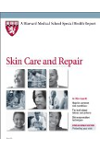Advertisement
These growths on the skin can be unsightly and get irritated and bleed, but seborrheic keratoses (pronounced seb-o-REE-ik ker-ah-TOE-sees) are very common and noncancerous. Typically, they start as small yellow or tan bumps and then gradually turn dark brown or black and develop a wartlike surface. They appear most often on the face, shoulders, chest, and back. Seborrheic keratoses are usually a little bit raised, so they look like they've been stuck on the surface of the skin. Some Africans, African Americans, and other dark-skinned individuals get a variant of the condition called dermatosis papulosa nigra, which consists of many black lesions on the cheeks.
People sometimes mistake seborrheic keratosis for melanoma, the most serious type of skin cancer, because in both, the growths are dark and have an irregular shape. Smaller, heavily pigmented seborrheic keratoses can, in fact, look a little like melanoma lesions. A dermatologist can usually tell the difference just by looking at them. If there's any doubt, he or she should get a biopsy (a tiny sample from the lesion) for microscopic examination.
It's not clear what causes seborrheic keratoses, although the tendency to have them is inherited, so there's probably a genetic component. Sun exposure is not a cause. Some people have just a few, others have hundreds.
I don't encourage the practice, but you can flick off a seborrheic keratosis. Or sometimes they get scraped off accidentally. Either way, pretty much the only risk is a little bleeding.
If seborrheic keratoses are treated, it's usually for cosmetic reasons. About 90% of the time I freeze them off. The procedure is similar to wart removal, but quicker. They can be scraped (curettage) or shaved off with a special cutting instrument. Removal sometimes creates an area with little or no pigment, so it looks white.
People sometimes mistake seborrheic keratosis for melanoma, the most serious type of skin cancer, because in both, the growths are dark and have an irregular shape. Smaller, heavily pigmented seborrheic keratoses can, in fact, look a little like melanoma lesions. A dermatologist can usually tell the difference just by looking at them. If there's any doubt, he or she should get a biopsy (a tiny sample from the lesion) for microscopic examination.
It's not clear what causes seborrheic keratoses, although the tendency to have them is inherited, so there's probably a genetic component. Sun exposure is not a cause. Some people have just a few, others have hundreds.
I don't encourage the practice, but you can flick off a seborrheic keratosis. Or sometimes they get scraped off accidentally. Either way, pretty much the only risk is a little bleeding.
If seborrheic keratoses are treated, it's usually for cosmetic reasons. About 90% of the time I freeze them off. The procedure is similar to wart removal, but quicker. They can be scraped (curettage) or shaved off with a special cutting instrument. Removal sometimes creates an area with little or no pigment, so it looks white.

More About this Book
Harvard Medical School Skin Care and Repair
Where can you get authorotative advice on skin care? There's plenty of advice out there on TV, the internet and in the aisles of stores peddling skin care products. Despite the abundance of products...
Continue Learning about Skin Disorders
Important: This content reflects information from various individuals and organizations and may offer alternative or opposing points of view. It should not be used for medical advice, diagnosis or treatment. As always, you should consult with your healthcare provider about your specific health needs.




